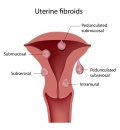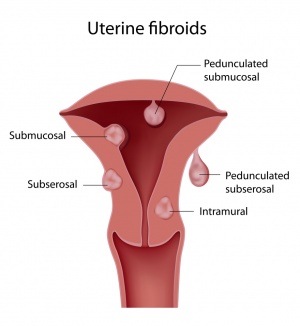Uterine Fibroids
Uterine fibroids, also known as leiomyomas, fibromyoma, myoma or fibroids, are the most common non-cancerous growths in women. They can occur as single or multiple growths in the uterus.[1] Fibroids may be present in up to 20-50% of reproductive aged women.[2] They arise after menarche and resolve by menopause.
|
Uterine Fibroids | |
| Causes | Dietary Factors, Alcohol, Smoking, Heavy Metals, Infections |
|---|---|
| See Also | Women's Health, Hypertension, Urinary incontinence, Dysmenorrhea |
| Books | Books on Women's Health |
| Articles | Articles on Women's Health |
Naturopathic Assessment
Causal Factors
In order to stimulate the innate ability of the body to heal the causes of disease must be identified and addressed. With uterine fibroids, the causes are variable and include lifestyle and environmental factors. A detailed assessment is required to determine which factors are contributing to uterine fibroids.
Lifestyle
- Consumption of fruit is linked to lower risk of uterine fibroids.[3]
- High dietary glycemic index (GI) and glycemic load may be associated with an increased risk of fibroids in some women.[4]
- It is suspected that there is a link between foods that increase estrogen and/or food intolerances and increased risk of uterine fibroids.
External
- Heavy cigarette smoking or longer history of cigarette smoking may increase risk of developing fibroids.[6]
Environmental
- Exposure to heavy metals that have an estrogen impact, like cadmium may increase the risk of fibroids.[8]
- It is suspected that there is an underlying yeast or mold infection in some cases.
Medical Interventions
- Prescription Medications
Genetics
- Ethnicity
- Black women are more likely to develop fibroids than caucasian women.[6]
Diagnostic Testing
A full health history including a detailed look at the pattern and symptoms of a women's period. A physical exam that includes a pelvic exam to inspect the size and shape of the uterus.
- Blood tests are often done to assess for signs of anemia or hormone levels.
- Other diagnostic testing may include an ultrasound, pelvic MRI and if indicated an endometrial biopsy or laparoscopy.
Related Symptoms and Conditions
- Bearing children decreases your risk of developing uterine fibroids by 20-40%. Risk is inversely correlated to number of births.[6]
- Birth after surgical removal of fibroids reduces risk of recurrence.[6]
Other conditions that are associated with fibroids include:
- Excess levels of the hormone estrogen.
- Increased body mass index or BMI.[6]
- Hypertension.[6]
- Fibroids may interfere with pregnancy and result in: ectopic pregnancy, miscarriage, preterm labour, and abdominal pain.[2]
- Urinary incontinence
- Urinary tract infections
- Dysmenorrhea
Characteristics
Fibroids are characterized as:[1]
- Benign tumours in the uterus.
- Microscopically small or grow so large that they fill the pelvis
- There may be one fibroid or many.
- Fibroids can be located in various areas of the uterus, and are named appropriately
- Myometrial fibroids: found in the muscle layer of the uterus
- Submucosal: located under the surface of the uterine lining
- Subserosal: found under the outer covering of the uterus
- Pedunculated: on a long stalk on the outside or inside the cavity of the uterus
- The risk of fibroids becoming cancerous is very small.
Common Symptoms
Fibroids, especially when small, may cause no symptoms at all. For larger fibroids the common symptoms include:
- Abnormal bleeding[1] including heavy or painful periods, passage of blood clots during the period, prolonged periods or bleeding between periods.[9]
- Periods that last longer than normal
- Pain or sensation of fullness or pressure in the lower abdomen or discomfort in the low back.[1]
- Compression of the bladder causing urinary frequency and incontinence.[1]
- Pain with intercourse
- Reproductive problems including infertility, multiple miscarriages, early onset labour.[9]
Naturopathic Treatment
The goal of naturopathic treatment is to support and work in tandem with the healing power of the body and to address the causal factors of disease with individual treatment strategies. The primary risks associated with fibroids include anemia due to the heavy bleeding. The naturopathic treatment strategy is to decrease the discomfort and risk of bleeding associated with fibroids and to address the underlying causes.
It is always advisable to work with a naturopathic doctor before engaging in any treatment plan.
Lifestyle
Lifestyle recommendations include:
- Eliminate alcohol, caffeine, saturated fats and sugar.[10]
- Consume a diet that focuses on whole unprocessed foods (whole grains, legumes, vegetables, fruits, nuts and seeds).[11]
- Focus on increasing fiber in the diet.[10]
- Increase consumption of soy foods.[11]
- Ensure you drink adequate water.
- Regular exercise is preventative and can decrease the growth of fibroids.
Naturopathic Therapies
Naturopathic Therapies for uterine fibroids include:
- Clinical Nutritional Supplementation includes
- Vitamins such as vitamin A, Vitamin B complex, vitamin K, vitamin C.
- Minerals such as iron, selenium
- Other supplements such as Flaxseed oil, Phosphatidylcholine,[11] pancreatic enzymes.[10]
- Herbs such as Chaste Tree (Vitex agnus-castus), Nettle (Urtica dioica), Burdock (Arctium lappa), Dandelion (Taraxacum officinale), Creeping barberry (Berberis aquifolium}.[10]
- Several compounded formulas have been used with moderate success including the following: Scudder's Alterative, Compounded Echinacea/Red Root, Compounded Fraxinus/Ceonothus, Compounded Gelsemium/Phytolacca.[10]
- Classical homeopathics: Gold salt (Aurum nat mur), Calcium iodide, Conium, Fraxinus, Hydrastis, Sepia, Thuja.[12], Sabina
- Complex homeopathics:
- According to TCM theory, Uterine fibroids may be caused by the following: Phlegm and food stagnation, Qi and blood stagnation, Yin and blood deficiency, Blood stagnation and qi deficiency, or Cold in the uterus.[13]
References
Reviewed by Iva Lloyd, BScH, RPE, ND [1]
- ↑ 1.0 1.1 1.2 1.3 1.4 Kumar R, Abbas A, DeLancey A, Malone E (2010) Robbins and Cotran Pathologic Basis of Disease. Eighth Edition. Saunders Elsevier.
- ↑ 2.0 2.1 Bajekal N, Li TC (2000 Nov-Dec) Fibroids, infertility and pregnancy wastage Hum Reprod Update;6(6):614-20 PMID: 11129696.
- ↑ Wise LA, Radin RG, Palmer JR, Kumanyika SK, Boggs DA, Rosenberg L (Dec 2011) Intake of fruit, vegetables, and carotenoids in relation to risk of uterine leiomyomata. Am J Clin Nutr.;94(6):1620-31. PMID: 22071705.
- ↑ Radin RG, Palmer JR, Rosenberg L, Kumanyika SK, Wise LA (May 2010) Dietary glycemic index and load in relation to risk of uterine leiomyomata in the Black Women's Health Study. Am J Clin Nutr.;91(5):1281-8. PMID: 20200259.
- ↑ Nagata C, Nakamura K, Oba S, Hayashi M, Takeda N, Yasuda K (May 2009) Association of intakes of fat, dietary fibre, soya isoflavones and alcohol with uterine fibroids in Japanese women. Br J Nutr.;101(10):1427-31. PMID: 19459228.
- ↑ 6.0 6.1 6.2 6.3 6.4 6.5 6.6 6.7 Viswanathan M, Hartmann K, McKoy N, Stuart G, Rankins N, Thieda P, Lux LJ, Lohr KN (2007 Jul) Management of uterine fibroids: an update of the evidence Evid Rep Technol Assess (Full Rep); Vol (154):1-122. PMID: 18288885.
- ↑ Baird DD, Dunson DB, Hill MC, Cousins D, Schectman JM (Jan 2007) Association of physical activity with development of uterine leiomyoma. Am J Epidemiol.;165(2):157-63. PMID: 17090618.
- ↑ Nasiadek M, Swiatkowska E, Nowinska A, Krawczyk T, Wilczynski JR, Sapota A (May 2011) The effect of cadmium on steroid hormones and their receptors in women with uterine myomas. Arch Environ Contam Toxicol.;60(4):734-41. PMID: 20711721.
- ↑ 9.0 9.1 Liu JP, Yang H, Xia Y, Cardini F (2009 Apr) Herbal preparations for uterine fibroids Cochrane Database Syst Rev; Vol(2) PMID: 19370619.
- ↑ 10.0 10.1 10.2 10.3 10.4 Pizzorno Joseph E, Murray Michael T (2000) A Textbook of Natural Medicine, 3rd Edition, Churchill Livingston
- ↑ 11.0 11.1 11.2 Murray Michael 1996 Encyclopedia of Nutritional Supplements, The Essential Guide for Improving Your Health Naturally Prima Publishing
- ↑ Hershoff Asa 2000 Homeopathic Remedies, A Quick and Easy Guide to Common Disorders and their Homeopathic Treatments Avery Publishing Group, New York
- ↑ Kuoch DJ (2011) Acupuncture Desk Reference Volume 2 2ND EDITION. Acumedwest Inc.

